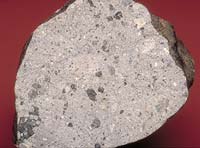|
COMETS EARTH JUPITER KUIPER BELT MARS MERCURY METEORITES NEPTUNE OORT CLOUD PLUTO SATURN SOLAR SYSTEM SPACE SUN URANUS VENUS ORDER PRINTS
PHOTO CATEGORIES SCIENCEVIEWS AMERICAN INDIAN AMPHIBIANS BIRDS BUGS FINE ART FOSSILS THE ISLANDS HISTORICAL PHOTOS MAMMALS OTHER PARKS PLANTS RELIGIOUS REPTILES SCIENCEVIEWS PRINTS
|
Related Documents
Download Options
The HED (howardite, eucrite and diogenite) meteorites are a large group of meteorites believed to originate from Vesta, a hypothesis that is consistent with current Dawn observations. Howardites are regolith breccia rocks, meaning that they formed through the grinding and fusion of rock and dust that occurs during meteor impacts on the surface of Vesta. Howardites are comprised of fragments of eucrite and diogenite of varying grain sizes, which can be seen in this picture of the Bununu howardite. This sample weighs 217 grams and was recovered in 1942 in Africa. Along with fragments of eucrite and diogenite, some howardites also contain solar wind implanted noble gasses, which confirms that they once resided on the surface of their parent body. This makes howardites a good laboratory analog for spectral and chemical measurements that will be made of the Vestan surface by Dawn. |
